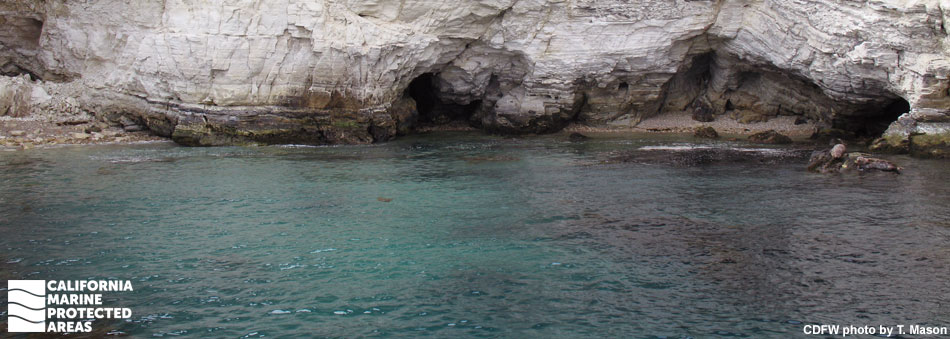
Overview
Blue Cavern Onshore State Marine Conservation Area (SMCA) (No-Take), and the larger Blue Cavern Offshore SMCA are adjacent marine protected areas (MPAs) located on Santa Catalina Island’s west end, a little more than 20 miles from the southern California mainland.
Blue Cavern Onshore SMCA (No-Take) protects around two and a half square miles of marine ecosystems to depths of nearly 900 feet. The SMCA has a wide range of underwater environments within its boundaries, including kelp-filled coves, surfgrass beds, pebble beaches, underwater caves, and rocky reefs. It also encompasses an area that was originally part of the Catalina Marine Science Center Marine Life Refuge, which protected Big Fisherman’s Cove for more than 30 years before it became part of Blue Cavern Onshore SMCA (No-Take) in 2012.
The University of Southern California’s Wrigley Marine Science Center is located onshore and adjacent to Big Fisherman’s Cove. Established in 1995, the research facility offers students and scientists easy access to a relatively secluded and undisturbed area that makes an excellent natural laboratory.
Protecting slightly less than eight square miles of marine ecosystems, Blue Cavern Offshore SMCA primarily protects sandy seafloor and offshore rocky reefs, including Isthmus Reef and Ship Rock, between depths of approximately 260 and 2,600 feet. This offshore MPA provides protection for species found in deep water such as rockfish and lingcod, while allowing limited fishing for pelagic fish such as yellowtail and Pacific bonito.
Regulations
Blue Cavern Onshore SMCA (No-Take)
It is unlawful to injure, damage, take, or possess any living, geological, or cultural marine resource. Also, no anchoring or mooring is permitted within the former Catalina Marine Science Center Marine Life Refuge.
California Code of Regulations Title 14, Section 632(b)(124)(opens in new tab)
Blue Cavern Offshore SMCA
It is unlawful to injure, damage, take, or possess any living, geological, or cultural marine resource, EXCEPT:
Recreational take of market squid by hand-held dip net, pelagic finfish (northern anchovy, barracudas, billfishes, dorado (dolphinfish), Pacific herring, jack mackerel, Pacific mackerel, salmon, Pacific sardine, blue shark, salmon shark, shortfin mako shark, thresher shark, swordfish, tunas, Pacific bonito, and yellowtail) by hook-and-line or by spearfishing, and white seabass by spearfishing is allowed. Commercial take of pelagic finfish (no commercial take of marlin is allowed) by hook-and-line, and swordfish by harpoon is allowed.
California Code of Regulations Title 14, Section 632(b)(125)(opens in new tab)
Quick Facts
Blue Cavern Onshore SMCA (No-Take)
MPA size: 2.61 square miles
Shoreline span: 2.2 miles
Depth range: 0 to 892 feet
Habitat composition*:
- Rock: 0.15 square miles
- Sand/mud: 2.54 square miles
Blue Cavern Offshore SMCA
MPA size: 7.70 square miles
Shoreline span: 267 to 2,616 feet
Habitat composition*:
- Rock: Less than 0.01 square miles
- Sand/mud: 7.69 square miles
*Habitat calculations are based on three-dimensional area and may exceed the total MPA area listed above.